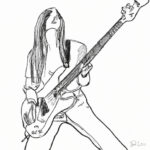Are those lumpy finger joints Heberden’s Nodes?
Guitarists often find themselves with arthritis in the fingers. If you’ve seen Keith Richard’s fingers in the past few years, you’ve probably noticed the arthritis. He can still play, and you should be able to as well. There are action steps that you can take to ease the arthritic destruction, pain, and restriction of what are called Heberden’s Nodes. Heberden’s nodes are bony swellings that can develop at the distal interphalangeal joints (DIP) of the fingers. They are often associated with osteoarthritis. While there is no cure for Heberden’s nodes, the following management strategies can help alleviate symptoms and improve quality of life: Pain management: Over-the-counter pain relievers like acetaminophen or nonsteroidal anti-inflammatory drugs (NSAIDs), suggested by your primary care doctor, may help reduce pain and inflammation. Always follow the recommended dosage and consult a Medical Doctor if you need a formal recommendation or have any concerns. Topical treatments: Some topical creams and gels containing capsaicin, CBD, THC or NSAIDs can be applied to the affected areas to reduce pain and inflammation. Discuss these options with your doctor to ensure they are appropriate for your situation. Heat and cold therapy: Applying warm compresses or using paraffin wax baths can...
read moreHip Pain in Guitar Players
Hip Pain in Guitar Players Playing the guitar is generally a pretty safe activity to be passionate about, but the repetitive motions involved can lead to various musculoskeletal issues. While most people associate guitar playing with hand and wrist pain, it’s important not to overlook the potential for hip pain. The hip joints play crucial roles in maintaining balance and supporting the body while sitting or standing during long practice sessions or performances. In this blog post, we will explore the causes, prevention, and treatment of hip pain in guitar players. Causes of Hip Pain Poor Posture: Slouching or leaning excessively while playing the guitar can strain the hip joints and surrounding muscles, leading to pain and discomfort. Extended Sitting: Long periods of sitting, which is common during practice sessions or performances, can contribute to hip stiffness and pain. Muscle Imbalances: Imbalances in the muscles surrounding the hips, such as tight hip flexors and weak gluteal muscles, can cause hip pain. Imbalances like these can stem from the way that you stand and sit asymmetrically while playing, or while not playing. Overuse and Repetitive Motion: Repeatedly performing, even practicing, can put strain on the hip joints over time. Prevention...
read moreWhat is the chance you will die because of an adjustment?
Read This List Of Chiropractic Dangers! The following is a list of the 20 most common accident-related causes of death in the United States. It’s important to note that the ranking and specific causes can vary depending on different years and data sources. The list below provides a general overview: (Source: ChatGPT) Motor Vehicle Accidents: Including car, truck, and motorcycle accidents. Drug Overdose: Involving both prescription and illicit drugs. Falls: Particularly among older adults. Accidental Poisoning: Including unintentional drug poisoning and exposure to harmful substances. Drowning: Involving both natural bodies of water and swimming pools. Fires and Burns: Including residential fires and workplace incidents. Firearms: Accidental shootings and unintentional firearm injuries. Suffocation: Often related to choking or unintentional strangulation. Pedestrian Accidents: Involving pedestrians being struck by vehicles. Bicycle Accidents: Involving cyclists being struck by vehicles. Medical Errors: Mistakes made in healthcare settings. Workplace Accidents: Including falls, machinery accidents, and exposure to hazardous substances. Accidental Poisoning by Carbon Monoxide: Often due to faulty heating systems or generators. Accidental Injuries in Construction: Falls, machinery accidents, and structural failures. Accidental Falls from Heights: Particularly in construction and industrial settings. Accidental Injuries from Machinery: Including industrial accidents and equipment malfunctions. Accidental Electrocutions: Due...
read moreY-Strap Chiropractor – Portland, Maine
What is the Y-Strap? The chiropractic Y-strap is a device used by some chiropractors during spinal adjustments to relieve tension in the neck and upper back. It consists of a padded strap that is placed around the patient’s head, with a handle at the end for the chiropractor to pull on. During treatment, the chiropractor will typically ask the patient to lie on their back while they hold the Y-strap handle and gently pull upwards. This action is thought to help decompress the spinal joints and stretch the neck muscles, which may provide relief from pain or discomfort. It is important to note that the use of the Y-strap is controversial within the chiropractic community, with some practitioners advocating for its use and others cautioning against it. Patients should consult with their chiropractic provider to determine if the Y-strap is an appropriate treatment option for their specific condition. Why is the Y-Strap Controversial? The y-strap is controversial because of how it “appears”. YouTube popularity of y-strap videos is very high, and these videos are extremely lucrative for those who post them. Many times, the videos do not show the back story, the evaluation, or the explanation for care, which...
read moreDysautonomia. Maybe it’s causing your internal “chaos”
Have you heard the term “Dysautonomia”? If you are feeling completely out of sorts, maybe you have IBS, heart palpitations, and fatigue? Maybe it’s high blood pressure, brain fog, and hot flashes? Read below and see if these facts about dysautonomia sound or feel familiar. Here is a list of 11 interesting facts about dysautonomia: Dysautonomia (autonomic dysregulation) is a medical condition that affects the autonomic nervous system, which controls many of the body’s automatic functions, such as heart rate, blood pressure, digestion, and temperature regulation. Because chiropractors have a direct impact on the autonomic nervous system with their adjustments of the spine, they believe that information on dysautonomia will be helpful to you. Dysautonomia is a broad term that encompasses several different types of autonomic dysfunction, including postural orthostatic tachycardia syndrome (POTS), neurocardiogenic syncope, and pure autonomic failure. Dysautonomia can affect people of all ages, but it is most commonly diagnosed in young women. Symptoms of dysautonomia can vary widely depending on the type and severity of the condition, but they may include lightheadedness, fainting, rapid heart rate, low blood pressure, gastrointestinal problems, and difficulty regulating body temperature. Dysautonomia is often misdiagnosed or underdiagnosed, as its symptoms can...
read more




